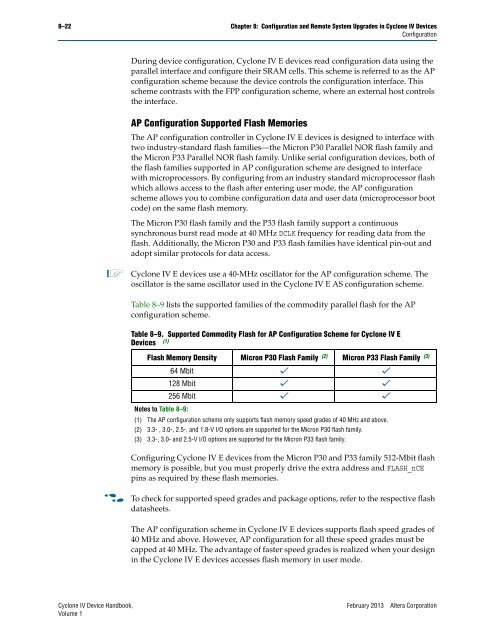Configuration and Remote System Upgrades in Cyclone IV ... - Altera
Configuration and Remote System Upgrades in Cyclone IV ... - Altera
Configuration and Remote System Upgrades in Cyclone IV ... - Altera
You also want an ePaper? Increase the reach of your titles
YUMPU automatically turns print PDFs into web optimized ePapers that Google loves.
8–22 Chapter 8: <strong>Configuration</strong> <strong>and</strong> <strong>Remote</strong> <strong>System</strong> <strong>Upgrades</strong> <strong>in</strong> <strong>Cyclone</strong> <strong>IV</strong> Devices<br />
<strong>Configuration</strong><br />
Dur<strong>in</strong>g device configuration, <strong>Cyclone</strong> <strong>IV</strong> E devices read configuration data us<strong>in</strong>g the<br />
parallel <strong>in</strong>terface <strong>and</strong> configure their SRAM cells. This scheme is referred to as the AP<br />
configuration scheme because the device controls the configuration <strong>in</strong>terface. This<br />
scheme contrasts with the FPP configuration scheme, where an external host controls<br />
the <strong>in</strong>terface.<br />
AP <strong>Configuration</strong> Supported Flash Memories<br />
The AP configuration controller <strong>in</strong> <strong>Cyclone</strong> <strong>IV</strong> E devices is designed to <strong>in</strong>terface with<br />
two <strong>in</strong>dustry-st<strong>and</strong>ard flash families—the Micron P30 Parallel NOR flash family <strong>and</strong><br />
the Micron P33 Parallel NOR flash family. Unlike serial configuration devices, both of<br />
the flash families supported <strong>in</strong> AP configuration scheme are designed to <strong>in</strong>terface<br />
with microprocessors. By configur<strong>in</strong>g from an <strong>in</strong>dustry st<strong>and</strong>ard microprocessor flash<br />
which allows access to the flash after enter<strong>in</strong>g user mode, the AP configuration<br />
scheme allows you to comb<strong>in</strong>e configuration data <strong>and</strong> user data (microprocessor boot<br />
code) on the same flash memory.<br />
The Micron P30 flash family <strong>and</strong> the P33 flash family support a cont<strong>in</strong>uous<br />
synchronous burst read mode at 40 MHz DCLK frequency for read<strong>in</strong>g data from the<br />
flash. Additionally, the Micron P30 <strong>and</strong> P33 flash families have identical p<strong>in</strong>-out <strong>and</strong><br />
adopt similar protocols for data access.<br />
1 <strong>Cyclone</strong> <strong>IV</strong> E devices use a 40-MHz oscillator for the AP configuration scheme. The<br />
oscillator is the same oscillator used <strong>in</strong> the <strong>Cyclone</strong> <strong>IV</strong> E AS configuration scheme.<br />
Table 8–9 lists the supported families of the commodity parallel flash for the AP<br />
configuration scheme.<br />
Table 8–9. Supported Commodity Flash for AP <strong>Configuration</strong> Scheme for <strong>Cyclone</strong> <strong>IV</strong> E<br />
Devices (1)<br />
Flash Memory Density Micron P30 Flash Family (2) Micron P33 Flash Family (3)<br />
Notes to Table 8–9:<br />
64 Mbit v v<br />
128 Mbit v v<br />
256 Mbit v v<br />
(1) The AP configuration scheme only supports flash memory speed grades of 40 MHz <strong>and</strong> above.<br />
(2) 3.3- , 3.0-, 2.5-, <strong>and</strong> 1.8-V I/O options are supported for the Micron P30 flash family.<br />
(3) 3.3-, 3.0- <strong>and</strong> 2.5-V I/O options are supported for the Micron P33 flash family.<br />
Configur<strong>in</strong>g <strong>Cyclone</strong> <strong>IV</strong> E devices from the Micron P30 <strong>and</strong> P33 family 512-Mbit flash<br />
memory is possible, but you must properly drive the extra address <strong>and</strong> FLASH_nCE<br />
p<strong>in</strong>s as required by these flash memories.<br />
f To check for supported speed grades <strong>and</strong> package options, refer to the respective flash<br />
datasheets.<br />
The AP configuration scheme <strong>in</strong> <strong>Cyclone</strong> <strong>IV</strong> E devices supports flash speed grades of<br />
40 MHz <strong>and</strong> above. However, AP configuration for all these speed grades must be<br />
capped at 40 MHz. The advantage of faster speed grades is realized when your design<br />
<strong>in</strong> the <strong>Cyclone</strong> <strong>IV</strong> E devices accesses flash memory <strong>in</strong> user mode.<br />
<strong>Cyclone</strong> <strong>IV</strong> Device H<strong>and</strong>book, February 2013 <strong>Altera</strong> Corporation<br />
Volume 1
















